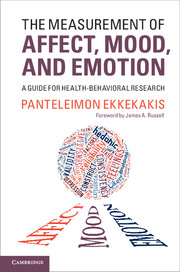Book contents
- Frontmatter
- Contents
- Figures
- Foreword
- Prologue
- 1 Documenting the breadth and depth of the problem
- 2 Untangling the terminological Gordian knot
- 3 Should affective states be considered as distinct entities or as positioned along dimensions?
- 4 Are pleasant and unpleasant states independent or polar opposites?
- 5 Selecting a measure
- 6 The old classics
- 7 Dimensional measures
- 8 Domain-specific measurement
- 9 Problems of domain specificity
- Epilogue
- References
- Index
4 - Are pleasant and unpleasant states independent or polar opposites?
Published online by Cambridge University Press: 05 March 2013
- Frontmatter
- Contents
- Figures
- Foreword
- Prologue
- 1 Documenting the breadth and depth of the problem
- 2 Untangling the terminological Gordian knot
- 3 Should affective states be considered as distinct entities or as positioned along dimensions?
- 4 Are pleasant and unpleasant states independent or polar opposites?
- 5 Selecting a measure
- 6 The old classics
- 7 Dimensional measures
- 8 Domain-specific measurement
- 9 Problems of domain specificity
- Epilogue
- References
- Index
Summary
The aim of this chapter is to survey the evidence pertaining to another important theoretical question researchers interested in measuring affect, mood, or emotion will have to confront during the process of selecting a measure. This question is whether pleasant and unpleasant states should be conceptualized as independent (unrelated to each other, which implies that people could feel both happy and sad at the same time) or as polar opposites.
Questions of bipolarity versus independence: what complexities lurk beneath the surface?
Readers may have encountered in the literature studies that employed the original unipolar version of the Profile of Mood States (McNair et al., 1971) and others that employed the more recent bipolar version (McNair, Lorr, & Droppleman, 1992). Most have probably never seen, however, a substantive explanation for why the unipolar or the bipolar version was preferred or what the implications would be of using one instead of the other. In the rare occasions on which a reason is given, it usually refers to issues, such as the relative popularity of the two measures, that are unrelated to the profound conceptual differences between them. For example, researchers have stated that their decision to focus on the unipolar version was based on the fact that it “remains the more commonly selected version of POMS by contemporary researchers of sport and exercise in preference to the POMS–Bi” and thus a study based on the unipolar version would have “relevance to a larger number of researchers” (Terry & Lane, 2000, p. 97).
- Type
- Chapter
- Information
- The Measurement of Affect, Mood, and EmotionA Guide for Health-Behavioral Research, pp. 76 - 95Publisher: Cambridge University PressPrint publication year: 2013



